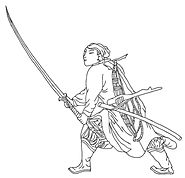Changdao (simplified Chinese: 长刀; traditional Chinese: 長刀; literally: "long knife") was a type of anti-cavalry sword used in China during the Ming Dynasty. Sometimes called Miao dao (a similar but more recent weapon), the Japanese ōdachi very much resembles this blade. This weapon was adopted by General Qi Jiguang, who acquired a Kage-ryū (Aizu) manual from Japanese wokou, studied and modified it for his troops and used against enemies on the Mongol border circa 1560. It replaced the zhǎn mǎ dāo as a "horse slaying" weapon; if the Japanese blades were derivatives of the zhǎnmǎdāo, the changdao would effectively be a third-generation replacement of the original sword. At the time of General Qi it had a specified length of 1.95 meters, similar to the Japanese ōdachi. Its handle was long, apparently slightly more than one-third of its total length, and its curve shallower than that of Japanese swords. Commanding up to 100,000 troops on the Mongol border, General Qi found this weapon so effective that up to forty percent of his commandos had it as a weapon; it stayed in service throughout the late Ming dynasty.
See also[]
| |||||||||||||||||||||||
| ||||||||||||||||||||||||||||||||||||||||||||||||||||||||||||||||||||||||||||||||||||||||||||||||||||
The original article can be found at Changdao and the edit history here.
